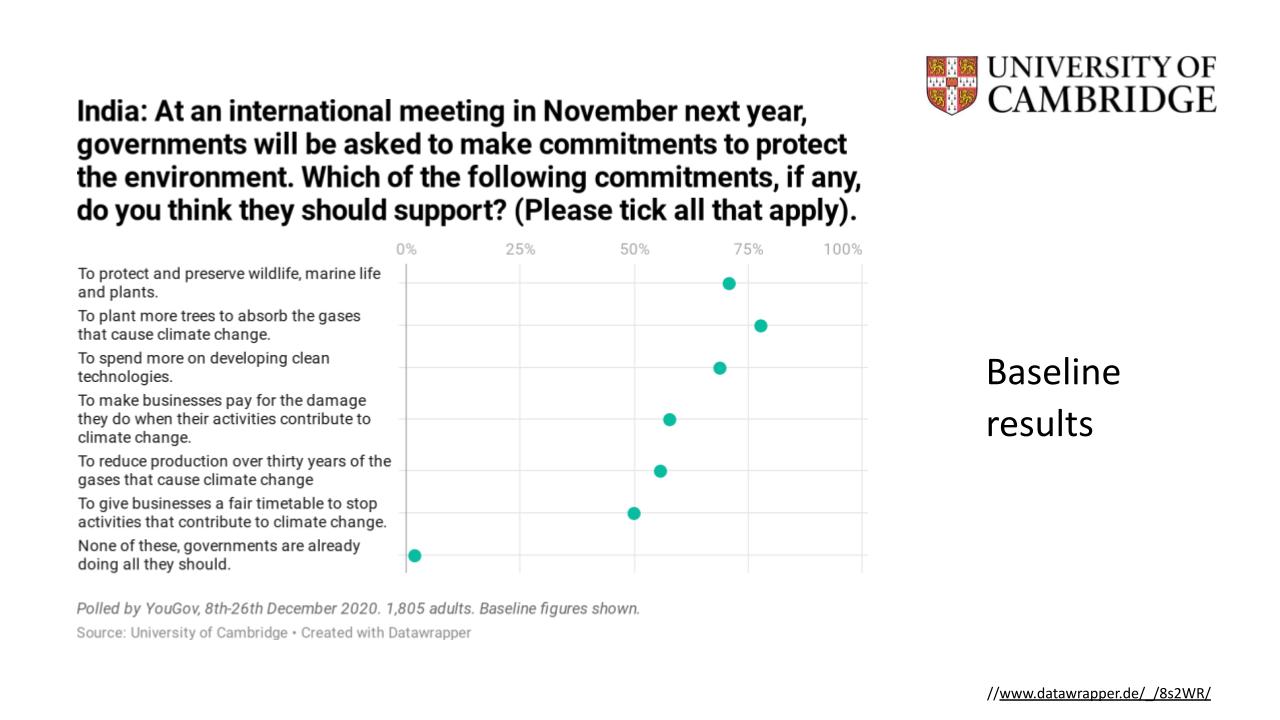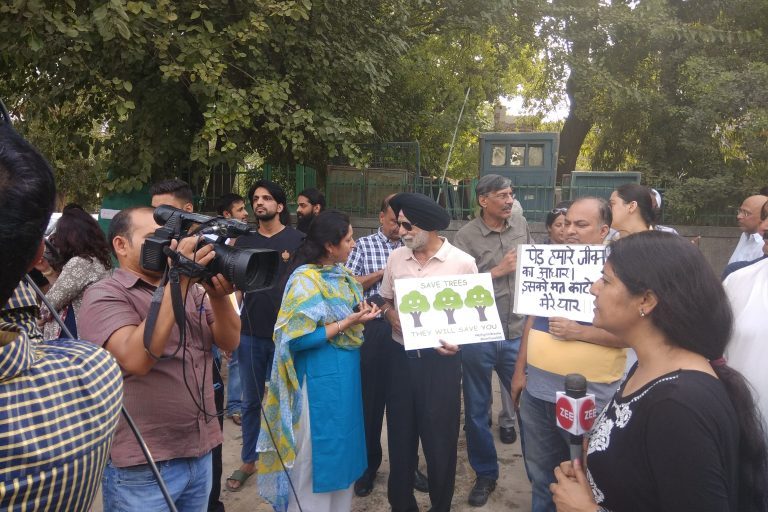- Ahead of the 26th United Nations Climate Change Conference of the Parties, a survey experiment spanning seven countries finds high levels of support for increased action on environmental protection.
- In India, where the survey represented adults in urban areas, policies on planting more trees (above 75 percent), protecting wildlife (74 percent) and spending more on clean technology (66 percent) found the most support.
- The widespread destruction of trees in urban India spawning local civic movements, youth climate activism and lived realities have likely spurred citizens to demand more government-led action on climate change.
An international survey experiment that tested public support for government action and policy solutions in seven major countries, in the run-up to the 26th United Nations Climate Change Conference of the Parties (COP26) in Glasgow, finds “high overall levels of support” for more action to protect the environment, including in India.
The policy with the most support in India was to plant more trees (above 75 percent), with protecting wildlife (74 percent) and spending more on clean technology (66 percent) coming in second and third, according to University of Cambridge researchers.
“COP26 is one of the most important opportunities in history for collective international action to tackle climate change. We wanted to understand the scope of public support for action across a range of countries, and to try and understand if that support could be increased by focusing on different aspects of climate change,” Lee de-Wit, a political psychologist at Cambridge, told Mongabay-India.
Researchers at the university worked with polling agency YouGov on a message-testing experiment fielding it to 14,627 adults, with samples of around 2,000 each in Brazil, China, India, Indonesia, Poland, the U.K. and the U.S. Polling took place from December 8 to December 31, 2020. The survey experiment revealed that a vast majority wanted ‘all national governments’ to do more to protect the environment. Since the Indian sample of 1,805 adults was representative of the urban community, the same policies may not be equally popular with rural voters, the researchers said.
“We live in a time of polarisation, and environmental issues have long embodied the political divisions in society. However, this may be changing,” de-Witt reflected on the survey experiment. One of the most significant factors, at play for the change, speculated de-Witt, is the “changing weather patterns around the world (more floods, more fires, more variability in weather), which has helped to literally bring the climate crisis to life for people,” said de-Wit.

Participants were randomly assigned to read either one of four “treatment” texts about climate change – drafted to reflect current UN messaging, public health, social norms and patriotism – or a neutral text, unrelated to climate and used to test “baseline” support. The participants were then asked if they agreed or disagreed with the statement that “all national governments should do more to protect the environment,” said a press release.
Baseline figures showed extremely high levels of support for government-led action. In six of these countries, at least nine out of ten participants agreed that governments should do more for the environment. In the U.S., the figure was three out of four (79 percent). Additionally, baseline figures were 70 percent for wildlife conservation, 67 percent for tree planting, and 60 percent for clean technology in the country. In the U.K., the most popular policy baseline figures were wildlife conservation (84 percent), tree planting (81 percent) and spending on clean technology (75 percent).
“In the U.K., I think the fact David Cameron explicitly committed the conservative party to tackle climate change (despite scepticism on the right), helped shift conservative thinking on the topic. I also suspect that prominent protests, by Greta Thunberg and Extinction Rebellion have played a part. Finally, there is evidence that one of the factors at play is that younger generations (who are generally much more accepting of the problem, and the need to tackle it), have been convincing older generations with talks over the dinner table within their own families and friendship groups,” observed de-Wit.
Prioritising environment protection in India was also reflected in a separate Pew Research Center survey conducted across 20 publics in Europe, the Asia-Pacific, Russia, the U.S., Canada and Brazil from October 2019 to March 2020. In this survey, in India, about 61 percent think protecting the environment should be given priority, even if it causes slower economic growth and some loss of jobs. A smaller share (25 percent) thinks creating jobs should be the top priority, even if the environment suffers to some extent; 70 percent say climate change is affecting where they live a great deal (28 percent) or some (42 percent).
Youth push for government action
Earlier this month, during his India visit, when asked in a media briefing about the role of youth climate activists, particularly in the context of the arrest of Disha Ravi, the United States Special Presidential Envoy for Climate John Kerry stated that “young people have been the key to pushing a lot of adults in the world to do what adults are supposed to do, which is get the job done.” Kerry shared that the United States supports India’s ambitious agenda for climate action during the 2020s, particularly its target of installing 450-gigawatts (GW) of renewable energy capacity by 2030 and wanted to “make sure that we’re (the US) facilitating the ability to reach that goal.”
Indian ecologist Harini Nagendra, who was not associated with the surveys, drew attention to the citizens’ movements birthed from the widespread destruction of trees across India’s urban areas. “The large scale tree felling in cities across India seems to be making citizens wake up. Youth movements like Fridays For Future have also had a definite impact, but locally rooted civic movements are also seen in many cities including Delhi, Bangalore and Hyderabad,” Nagendra, Professor of Sustainability, Azim Premji University, told Mongabay-India.

In 2018, in New Delhi, India’s capital with a population of 11 million where an average of 24 trees was felled per day between 2005 to 2018, residents rallied against the proposed felling of more than 16,000 trees for a project to build housing for government officials. In Bengaluru, once known for its lush greenery, residents formed a human chain in protest against the cutting of 25 old-growth trees. In 2020, over 50 youth unions from India submitted a letter to the environment ministry to condemn the Environment Impact Assessment (EIA) Notification 2020 on account of how destructive it can prove to be for the ecology and the people of India. In the letter, the youth expressed hope that the EIA can be amended and used to bring India out of the COVID-19 pandemic through a green recovery that strengthens the role of environmental and social protection of all people and nature instead of justifying the present forms of harmful development.
Concerned citizens have also taken to art, craft and music to protest illegal coal mining in an elephant reserve and to save a bird sanctuary, for instance. The rise of youth climate activism in urban areas, while fueling hope, has also found its detractors, evidenced by the arrest of Disha Ravi over sedition for allegedly editing a toolkit shared by Greta Thunberg on the farmers protest in India in February 2021.
Businesses should pay for contributing to climate change
The Cambridge survey also asked which policies governments should support at COP26. In each of these seven countries, baseline figures showed that at least 50 percent supported four policies. The most popular on average was action “to protect and preserve” wildlife, marine life and plants; followed by a policy “to plant more trees to absorb the gases that cause climate change”; then spending more on developing clean technologies; then reducing “the production over thirty years of the gases that cause climate change.”
Participants were also asked if they thought that businesses should be made “to pay for the damage they do when their activities contribute to climate change”. In every country except China, baseline figures showed this to be a more popular policy than giving businesses a “fair timetable to stop activities that contribute to climate change.” Across the seven countries, on average, 58 percent supported making businesses pay and 48 percent supported the timetable option.
In India, 55 percent of respondents supported making businesses pay for the environmental damage they cause, 57 percent supported reducing production of greenhouse gases over 30 years and 53 percent supported giving businesses a fair timetable to stop activities that contribute to climate change. Only two percent felt governments are already doing all they should.
Lee de-Wit thinks that the three policy areas that attract support from around 70 percent of the sampled population in India (plant more trees, protect wildlife and clean energy) could be good areas to focus on for attracting further support.

Nagendra adds that public pressure shapes government policies and this should be done proactively as well, by organising community plantation drives in conjunction with neighbourhoods and schools/colleges that adopt trees in cities, for example. “Of course making sure that the right (ecologically suited) trees are in the right places.”
The surge in citizen science action has also helped strengthen public support for environmental action in urban India. “Look at the birdwatching and nature groups in cities across India, and the impact they have had on creating generations of naturalists and young people who have gone on to work in environment/conservation. Citizen science can play a major role, as the growing popularity for e.g. of eBird shows. But it has to be done carefully so that there is an engagement that goes beyond making and crossing off checklists,” Nagendra noted.
Banner image: Locally rooted civic movements such as those by Mumbai residents for protecting Aarey forest and its leopards showcase the demand for climate action and environment protection by citizens. Photo by Kartik Chandramouli/Mongabay.
